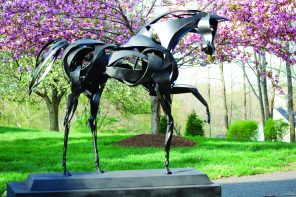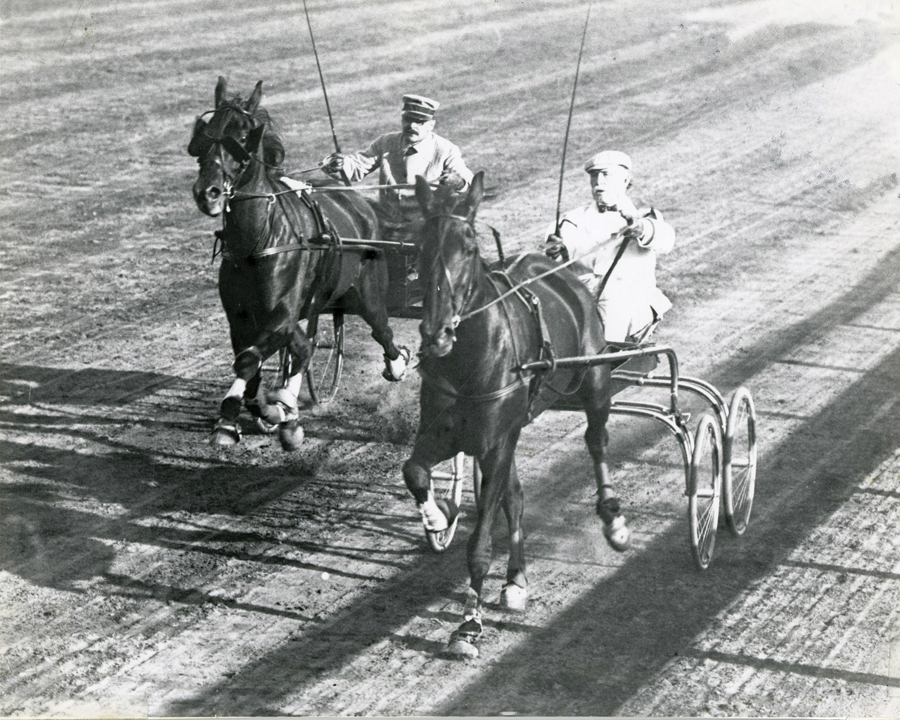The breeze of the Pacific swept between her seats as she cruised the California coastline. A 1950s Italian stunner in white and chrome, her twin cam 1300 cc motor purred as she hugged the curves with a finesse fit for the Amalfi Coast. Was she headed north or south? Monterey or Malibu? Or destined for the bright lights of Hollywood?
Not much is known of this vintage beauty, a 1956 Alfa Romeo Giulietta Spider, but that until recently she lived in California. And after nearly 60 years – the most recent spent in neglect – she found her way to a second life with Nick Soprano.
“She’s a survivor,” Soprano says. “We did some upholstery work, some chrome work and some paint work. I gave her a good tune-up and a thorough detailing and brought it up to the very high level that you see today.”
Completely restored and in model running condition, the Giulietta is just one of the vintage vehicles to benefit from Soprano’s decades of expertise at Motor Classic & Competition Corp. Part club, part clearinghouse, his Bedford Hills company specializes in sports, racing and GT cars of the 1950s, ’60s and ’70s.
“We buy and sell, trade, repair and restore,” he says. “People come in looking for cars and if I don’t have them, we’ll find the car for them. If they have a car to sell, we will either buy it or take it on consignment.”
But enough talk about business. To Soprano, cars aren’t business. They’re life.
“There’s a deep philosophy here. It’s not just buying and selling cars. It’s a thing of passion. It’s an art form.”
Though he could talk technical specs all day, Soprano fervently praises the “self-evident” purity of design among classic cars such as the revived Giulietta. Like a sculpture by the masters – or a flawless human form – every side is her best side.
“They are a timeless, pure form,” he says. “It flows. One line flows into the other and you can’t take your eyes off it. You keep walking around the car, because there are so many beautiful angles.”
The roadster
Almost instinctively, I found myself doing just that – circling the Giulietta with camera in hand repeatedly spotting shot after elegant shot.
“People come in and are fascinated by the shapes and don’t know why. It’s because they have the essential art appreciation deep within themselves so when they see these forms, they are just mesmerized, fascinated and intrigued by them.”
As he acclaims the autos’ allure, he equally commends their creators.
“The cars of that era were built by passionate and enthusiastic men, men who wanted to express themselves in metal,” he says.
The makers of Italian sports cars specifically showed artisanship, craftsmanship and ingenuity that were “very technologically outstanding to the competition at the time,” Soprano says. “They effectively and efficiently used the resources that they had. So it’s not a big engine displacement-wise, but it puts out a lot of power for its size, especially in terms of the period it was built in.”
Under the hood, the petite Giulietta holds a 1300 cc motor that today rivals some motorcycle engines. But designers opted for aluminum casting instead of iron – the coarser, weightier, cheaper metal of choice in that day – which kept her light, gas-efficient, and able to reach speeds of 110 mph. Indeed, she strikes the ideal balance of the beautiful and the practical.
“Here’s a little two-seater car that doesn’t weigh much more than 2,100 pounds that can carry two people, be a lot of fun to drive and still have enough room for a spare tire and more than a weekend’s worth of luggage to be stored in the trunk.”
Her original owner surely benefitted from sophisticated taste as well as deep pockets, so the notion that a notable name piloted this Giulietta isn’t far-fetched.
“A lot of very celebrated people did buy Alfa Romeo, because especially pre-war they were an intriguing mark that won all kinds of races,” including Le Mans.
Alfa Romeo made just 1,000 of the Giulietta, which by ’50s standards indicated mass production. But speaking to value by contemporary standards, Soprano says “they’ve proven to be quite an investment.”
The racer
Like art collectors, Soprano says many of his club’s classic car enthusiasts collect “four-wheeled art” simply to gaze upon its exquisite lines. Other members – patrons may be a better term – take their art to the track and enlist Soprano as pilot.
“I’ve been entrusted by clients and friends to drive some extraordinary vintage racing machinery due to my track experience and racing know-how.”
That’s putting it humbly (and he emanates humility). In fact, Soprano has been well-acquainted with podium finishes during his decades-long racing career that includes Formula Atlantic, or Formula 2, as well as illustrious international vintage sports car events.
“There are a lot of events worldwide where all these old cars get together and run the same races in the same classes as they did back then. So you get to experience the history that you were perhaps too young to experience at the time,” he says. “I had the good fortune to participate in a lot of those racing events.”
His record of race cars reads like a dream sequence of any kid who hand-selected their Hot Wheels. Nick raced a Maserati 450S, Ford GT40 and Ferrari 250 GTO on courses like Lime Rock Park in Litchfield County’s Salisbury, where Paul Newman used to race; the Mazda Raceway Laguna Seca; the former Moroso Motorsports Park (now once again the Palm Beach International Raceway); Watkins Glen International; Nelson Ledges Road Course; and Elkhart Lake’s Road America Inc. He even took the Maserati along the 1,000-mile Italian course where once was held the nefarious Mille Miglia.
“It’s a transcendent experience, especially for an old-car guy.”
Soprano knows he’s lived the dream.
“I was born with the dream. Even as a very young person, I was fascinated with machines and cars. The dream developed as I read about what the all-time racing greats did when I was a very young boy – Stirling Moss, Fangio and all the great names. I made it my life’s work to experience to the best degree that I was able what those men did back in the ’50s and ’60s.”
And he did. Today, his showroom features photos of Soprano – “once upon a time,” he says – alongside icon Stirling Moss and another with Carroll Shelby, creator of the Shelby Cobra, who raced in Soprano’s Maserati. He even met Fangio. And in a hallowed spot behind his desk hangs an oversize framed photo of Soprano with Enzo Ferrari.
“That’s the man who made Ferrari cars,” he says in almost a whisper.
To his clients across the globe, Soprano is a portal to their own dreams. They live vicariously on the track with Soprano behind the wheel, rooting for their cars – as well as their buddy – and experiencing the thrill of the race in sight and sound.
“The cars are extraordinary visual forms, but then when you hear them, their engines going by at full tilt down the straightaway, a Ferrari at 9000 rpm produces an aria and a symphony of sound that will awaken the senses to levels beyond anything you’ve experienced before.”
But as a racer, like as a businessman, Soprano has a deeper agenda – rebuilding the relationship between man and machine.
“Today so many people look at a car like an appliance. It’s built by robots, you look at the motor you don’t know what you’re looking at because it’s filled with all this technology, which is good, but it’s another way to isolate you from being one with the car. The old cars are more of a visceral art form that you could interact with and learn from.”
But the art of racing, of course, is highly competitive and highly dangerous.
“Vintage racing allows us to hit the same top speeds and face the same road challenges on the same tracks that racers did back in period.”
One race left him with a broken back. But, as Soprano contends, the heart of a racer is stronger than mangled bones.
“Racing is something that I think comes from within the self. If you have the desire, it goes beyond the consideration of the risk. The drive of the racer overwhelms all that. It’s greater than all that. You do it because it’s really an emotion that’s rooted in love.”
For Soprano, that love kept his dream of the drive alive. The Giulietta, I think, feels the same.
Motor Classic & Competition Corp. is at 350 Adams St. in Bedford Hills. For more, call (914) 997-9133 or email sales@motorclassiccorp.com.






